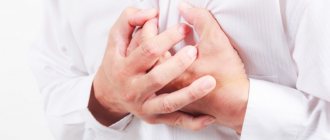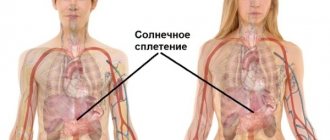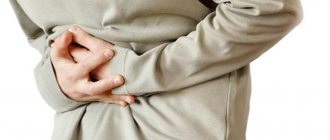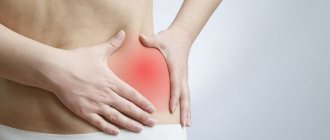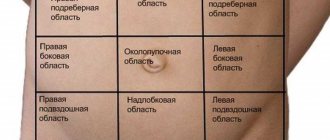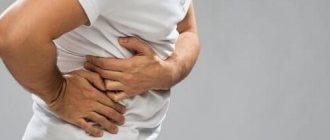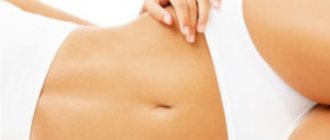The solar plexus also has another name - the splanchic plexus. It contains a large center of nerve cells, which extend with nerve endings in different directions. Nerve fibers emanating from the solar plexus are connected to the nerve endings of almost the entire body. Thanks to this structure, communication between internal organs and the central nervous system is ensured.
Any pain or feeling of heaviness in the solar plexus is a projection of a disease of any organ and serves as a signal of the development of pathology. Also, these unpleasant sensations can occur due to mechanical trauma to this area or due to frequent nervous stress.
High-intensity physical activity and various types of injuries
Most often, discomfort occurs in novice athletes. This does not indicate the presence of any pathology in the body, but is a kind of “bell” indicating that the person is doing the exercises incorrectly.
Heaviness in the solar plexus can also occur in professional athletes. In this case, the presence of discomfort indicates that the physical activity is too intense. In addition, heaviness is accompanied by pain. The latter is acute (burning or stabbing) in nature. Sometimes the pain is so severe that a person is forced to interrupt the workout and rest.
As a rule, pain and a feeling of heaviness in the solar plexus, which occurs against the background of high-intensity physical activity or improper exercise, are not an alarming symptom. If they occur, it is enough to interrupt the workout and rest. Then it is recommended to make adjustments to the lesson plan. It is important to remember that overwork has a negative impact on your health. Beginners need to master the technique of performing exercises.
However, it is worth knowing that regular high-intensity exercise, accompanied by pain and heaviness in the solar plexus, can lead to the development of an inflammatory process in the nerve fibers. And this is a condition that requires medical intervention.
Also, one of the most likely causes of heaviness in the solar plexus is some kind of injury. The latter may be a consequence of:
- Impact. This is especially true for athletes involved in wrestling. Even a ball hitting the solar plexus while playing football can cause significant discomfort.
- Falling and, accordingly, hitting any surface.
- Strong tightening of the belt on the stomach. In addition, heaviness also appears when wearing tight, high-waisted trousers.
After receiving an injury, a person experiences heaviness and burning pain. Discomfort is localized in the area between the lower edge of the sternum and the navel.
In addition, if the cause of their occurrence is injury, after receiving the latter, other alarming symptoms may appear:
- Nausea.
- Frequent urge to perform an act of defecation.
- Sensation of burning and warmth inside the abdominal cavity.
- Violation of the breathing process. Most often it is very difficult to take a breath.
- Painful sensations can radiate to the chest, in particular to the heart area. At the same time, they are stupid in nature.
- If the discomfort is severe, the person involuntarily bends his knees and presses them to his stomach.
As part of first aid, the victim must be laid on a flat surface and forced to breathe evenly. As a rule, to do this, it is enough to straighten it. In addition, if the injury is minor, you can massage the victim's solar plexus area.
If you suspect a serious injury, you should call an ambulance. Doctors will transport the victim to a hospital, where they will competently draw up a treatment plan for him.
Dependence of diagnosis on pain localization
The localization of the pain syndrome will help to roughly guide you in the search for the disease.
Localization of pain - to the left of the plexus
Pain to the left of the solar plexus can occur with one of the following pathologies:
- stomach or duodenal ulcer;
- gastritis, gastroduodenitis;
- tumors of the stomach or duodenum;
- tumors or inflammation of the tail of the pancreas;
- urolithiasis;
- prolapse of the left kidney;
- intercostal neuralgia on the left;
- pyelonephritis.
Pain – to the right of the plexus
If the pain syndrome is located to the right of the midline connecting the sternum and the navel, this may be in favor of:
- appendicitis;
- cholecystitis;
- hepatitis A;
- cholelithiasis;
- right-sided intercostal neuralgia;
- liver tumors;
- inflammation, tumors or burns of the lower part of the esophagus;
- pyelonephritis, hydronephrosis or stone - in the left kidney.
Soreness – below the solar plexus
Pain under the solar plexus is characteristic of the following diseases:
- Genital organs (mainly in women): fallopian tubes, ovaries.
- Bladder, ureters (more often such irradiation is typical for men).
- Large intestine (colitis, sigmoiditis, proctitis)
The painful area is located above the solar plexus
Pain above the plexus is typical for:
- Diseases of the esophagus (esophagitis, tumors, erosions, burns). An additional symptom in this case will be pain when swallowing, located behind the sternum. Belching and nausea will also be noted.
- Pathologies of the pleura (pleurisy, empyema). They develop as complications of pneumonia or tuberculosis. Their connection with breathing speaks in their favor.
- Pneumonia (usually lower lobe). Typically, this pathology occurs with fever and muscle pain. If it is not treated for some time, shortness of breath and a feeling of lack of air develops.
- Heart disease. Here, the pain is associated with anxiety or physical activity, and is alleviated by taking nitroglycerin or with long-term use of drugs such as Anaprilina, Atenolol, Nebivolol. If the pain is severe and occurs after several years of attacks that were relieved with nitroglycerin, it may be a myocardial infarction.
- Diseases of the diaphragm (most often a diaphragmatic hernia, when the abdominal organs enter the chest cavity). In this case, there may be heart rhythm disturbances and difficulty breathing after eating, especially if the person then assumes a horizontal position.
- Intercostal neuralgia. With this pathology, in the affected intercostal space you can sometimes find a blistering rash of herpes zoster or palpate the pinched vertebra by pressing on each individually. Symptoms of intercostal neuralgia will be the appearance of pain above the solar plexus on the right or left, which radiates to the left or right hand (respectively). It hurts to take a deep breath or cough. The temperature rarely rises; symptoms of intoxication (nausea, weakness, muscle or bone pain), which distinguishes this pathology from pleurisy.
Neuralgia
Another common cause of heaviness in the solar plexus. The term “neuralgia” refers to a pathological process, the course of which is accompanied by irritation of nerve fibers.
At the initial stage of development of the disease, the only concern is heaviness in the solar plexus. But soon intense pain appears. It is so sharp and sharp that a person has to make a lot of effort to inhale. Thus, if a person is bothered by heaviness in the solar plexus and has difficulty breathing, in 80% of cases we are talking about neuralgia. Some patients are also bothered by a feeling of heat in the area.
The causes of the disease are very diverse. Neuralgia may result from:
- Intervertebral hernia.
- Osteochondrosis.
- Various types of lower back injuries.
- Fracture of the femur or pelvic bones.
- The appearance of a neoplasm. The latter can be both benign and malignant.
- Hypothermia of the thighs, lower back or buttocks.
- A lifestyle that does not involve physical activity.
- Intense loads on the lumbar region.
- Pregnancy.
- Obesity.
- Progression of pathologies of the pelvic organs.
If heaviness occurs in the solar plexus, you should consult a therapist. The specialist will take a medical history and conduct a physical examination. If neuralgia is suspected, the therapist will refer you to a neurologist for treatment.
Diagnosis of the disease involves undergoing the following studies:
- NMR.
- CT.
- X-ray.
In addition, it is necessary to donate blood and urine for general and biochemical examination.
The classic treatment regimen for neuralgia is as follows:
- Taking anti-inflammatory drugs. The therapy also relieves pain. Most often, doctors prescribe Baclofen and Ibuprofen.
- Taking or intravenously administering medications containing B vitamins.
- Taking a course of physiotherapy. As practice shows, acupuncture helps achieve good results.
Treatment of women during pregnancy is carried out in a hospital setting.
Diagnostic methods
Immediately after a person experiences pain inside the chest, it is necessary to consult a doctor. Due to the fact that there can be many possible factors that provoke the appearance of pain, an adult patient should consult a therapist. The doctor will conduct an initial examination and issue a referral to a specialized specialist for a more accurate examination, if this is urgently necessary. If the pain is severe, he will tell you what to take to relieve it. The child is examined by a pediatrician.
Solarite
In medicine, the disease is also called idiomatic peripheral autonomic neuropathy. In the medical literature you can also find the concept of “solar plexitis”. Behind all these terms lies an inflammatory process occurring in the solar plexus.
The main reasons for the development of solarite:
- Injuries resulting from a fall or blow.
- Lordosis.
- Enteroptosis.
- Abdominal aortic aneurysm.
- Spinal pathologies of a dystrophic or degenerative nature.
- Inflammatory processes in the abdominal organs.
- Flu.
- Peritonitis.
- Syphilis.
- Tuberculosis.
- Helminthic infestations.
- Colitis.
- Poisoning by chemical compounds.
- Tobacco smoking.
- Regular consumption of alcoholic beverages.
- Lesions of the hypothalamus.
- Prolonged stay in a state of stress.
The main symptom of solaritis is heaviness in the solar plexus. At the same time, the discomfort is in no way related to food intake. There is pain when lying on your back. The latter is aching and boring in nature.
Sometimes the course of the disease is accompanied by a short-term deterioration in health. Symptoms appear suddenly and disappear abruptly. In this case, it is customary to talk about a solar crisis. It can occur every day or even once a month. A solar crisis is always accompanied by pain and a feeling of heaviness in the solar plexus.
In addition, the following symptoms may occur against its background:
- High blood pressure.
- Tachycardia.
- Stool disorders.
- Headache.
- Nausea.
- Vomit.
- Fear of death.
- Inadequate perception of reality.
- Uncontrolled aggression.
If signs of solaritis occur, you should consult a physician. Based on the results of the initial diagnosis, he will refer you for a comprehensive examination, including consultations with a gastroenterologist, neurologist, surgeon and infectious disease specialist.
The goal of treatment is to eliminate the provoking factors that triggered the development of solaritis. When a crisis occurs regularly, symptomatic therapy is paramount.
The classic treatment regimen for solaritis is as follows:
- Taking painkillers and antispasmodics. As a rule, doctors prescribe No-shpu, Papaverine and Tifen.
- Taking adrenergic and ganglion blockers. Most often, doctors prescribe Anaprilin and Pentamin.
- UHF therapy.
- Segmental massage.
- Vacuum therapy.
- Taking vitamins A, C and group B.
- Electrophoresis with calcium.
- Exercise therapy.
In addition, people who periodically suffer from a crisis are advised to undergo sanatorium-resort treatment.
Diagnostics
It is impossible to determine on your own why the solar plexus hurts, so it is important to consult a doctor in a timely manner. The symptom appears for various reasons. Some do not pose a threat to health, others, on the contrary, are life-threatening. Therefore, it is important to conduct a diagnosis, which may include the following methods:
- General clinical tests.
- Ultrasonography.
- CT scan.
- X-ray method using contrast.
- Laparoscopy.
- Fibrogastroduodenoscopy.
Stomach ulcer
This is a pathology, the course of which is accompanied by the formation of specific defects in the gastroduodenal zone. Ulcers can be either multiple or single.
The main reason for the development of the disease is ignoring the signs of gastritis, which, in turn, arose against the background of active activity of Helicobacter pylori.
However, the presence of infection in the body does not guarantee the occurrence of the disease. The process of disease development starts only when exposed to one or more provoking factors.
These include:
- Frequent consumption of alcoholic beverages.
- Irregular and unbalanced diet.
- Long-term use of medications.
- Overstrain (both nervous and physical).
- Lack of vitamins in the body.
- Prolonged stay in a state of stress.
- Injuries to the abdominal organs or spine.
- The presence of blood clots in the blood vessels supplying the stomach.
- Sleep deficiency.
Clinical manifestations and their severity directly depend on the location of the ulcer and the individual characteristics of the body. The main symptoms of the disease are pain and heaviness in the solar plexus area after eating. However, some patients complain only of mild discomfort. Others say the pain is unbearable.
Signs of pathology (except for heaviness in the solar plexus):
- Belching. It has a sour taste.
- Heartburn.
- Nausea that occurs immediately after eating.
- Vomit. It brings significant relief.
- A sharp decrease in body weight.
- Sleep disorders.
- Anemia.
The most alarming symptom is vomiting associated with coffee grounds. It indicates internal bleeding.
Diagnosis of the disease involves undergoing a comprehensive examination, including:
- FGS. During the procedure, a sample of the mucous membrane near the ulcerative lesion is taken.
- Bacteriological examination of tissues for the detection of Helicobacter pylori.
- X-ray with contrast.
- Clinical and biochemical blood tests.
All therapeutic measures are aimed at relieving unpleasant symptoms and eliminating the root cause of the development of pathology. The duration of conservative therapy can be up to 2 months. If it is ineffective, the doctor evaluates the feasibility of surgical intervention.
Conservative treatment involves taking the following groups of drugs:
- Antacids (Almagel, Maalox, Gastal, Gaviscon, Vikair).
- Antisecretory agents (Omeprazole, Ultop, Ranitidine).
- Cytoprotectors (“Andapsin”, “Sucralfate”, “Carbenoxalone”).
- Antiulcer drugs (Verapamil, Nifedipine, Isoptin).
- Antibiotics (if Helicobacter pylori is detected).
- Pro- and prebiotics (“Normobakt”, “Linex”, “Bifidumbacterin”).
- Prokinetics (“Cerucal”, “Motillium”).
- Sedatives (“Motherwort”, “Valerian”).
- Vitamin complexes.
Ignoring the need for treatment leads to the development of complications, in particular, oncology.
Nature of sensations
The solar plexus contains nerve endings, which means that pain there can be varied and associated with various phenomena (pain may well travel along neurons from an area located elsewhere). But it is important to determine the nature of the pain and the time of its manifestation. Please note the following important factors:
- At what time does pain most often occur: in the morning, at night, in the evening or during the day?
- After what actions do unpleasant sensations appear in the solar plexus? They probably occur after exercise, stress, or after eating. Or it may be that pain has nothing to do with actions.
- Determine the nature of the sensations. They can be sharp and strong, aching, dull, cutting. Some experience burning or bloating.
- Were any injuries or damages preceding the unpleasant sensations?
Pain in the solar plexus area can be caused by a wide variety of factors, because not only nerves, but also important organs are located in this area.
Let's describe some of the causes of troubles and dwell in more detail on each of them.
Neuritis
Neuritis is an inflammation of the nerve endings located in the solar plexus.
This disease can be caused by a variety of reasons: surgical interventions, large and intense physical activity, a sedentary lifestyle, problems with the nervous system, some infections, as well as the consequences of injuries.
Pain in this case can occur at any time; it often does not depend on external factors, although sometimes it appears after stress or sudden movements.
The sensations are strong, often cutting or even drilling. When changing position or loads, they may intensify.
Sometimes the pain is localized not only in the solar plexus itself, but also in the area of the entire abdominal cavity and radiates to the sides, back and lower back. The patient can bend over and press his knees to his chest to alleviate his condition.
To cure neuritis, you need to find and eliminate its cause (virus, bacteria, nerve problems, etc.). Symptoms are also relieved.
Neuralgia
This condition is similar to neuritis and occurs due to irritation or compression of the nerves. In such a situation, the pain in the solar plexus area will be sharp and severe. There is a feeling as if this area was squeezed in a vice, squeezed tightly.
Sometimes it can be difficult to breathe and change your body position. The causes of this disease may be the following: pathologies and diseases of the nervous system, trauma, infections or parasitic infestations. Treatment involves relieving pain and eliminating the cause of nerve irritation.
Solarite
If pain in the solar plexus continues for a long time and begins to be chronic, then we can talk about solaritis - a disease associated with inflammation and damage to almost all nerves located in the solar node.
Many endings are localized in this plexus; here they intertwine and connect. Typically, this disease develops in the absence of treatment for neuralgia or neuritis.
It can manifest itself in attacks, but the symptoms can become dull and persist for a long time (in the chronic form).
Let us list some manifestations of solarite:
- Pressing, aching and dull pain in the sternum and in the area where the heart is located. It can be observed for a long time.
- During an attack, pain in the solar plexus becomes acute, strong and sharp, it can radiate to the sides or back.
- You may feel hot inside, although at this time your body temperature will be completely normal.
- Sometimes there is heaviness in the abdomen, distension and bloating.
- As a result of the effect on the tone of the stomach, symptoms such as nausea, belching, heartburn and even vomiting, as well as constipation, may occur.
Treatment of such a disease includes elimination of the source of irritation, anti-inflammatory therapy, the use of painkillers and antispasmodics, as well as physical therapy methods.
Stomach
Part of the stomach is located almost in the solar plexus, so diseases of this organ can be accompanied by unpleasant sensations in this area. Pain can occur with gastritis, ulcers or tumors.
In the first two cases, symptoms occur during fasting or after eating spicy food (the secreted juice begins to irritate the walls, which, for example, are inflamed in ulcers and gastritis).
And the symptoms of a tumor often do not depend on external factors. Pain is not the only symptom. Digestive disorders may also occur: bloating, nausea or vomiting, belching, and so on.
Treatment for such diseases is prescribed by a doctor. But in most cases, a special gentle diet is indicated, as well as taking medications to improve digestion and reduce the acidity of gastric juice.
Duodenum
Pain in the solar plexus can be caused by duodenitis - inflammation of the duodenum. In this case, pain often occurs when a person is hungry (they are especially severe at night). In addition, vomiting or nausea, weakness, loss of appetite, and even fever may occur.
And in some cases, pain occurs only when pressing on the area. With an ulcer, the manifestations are more pronounced, but with tumors, on the contrary, they may be subtle. Treatment of duodenitis will depend on the causes of its occurrence. To eliminate symptoms, agents that envelop the mucous membranes are prescribed, as well as drugs to reduce the acidity of the environment.
Small intestine
This part of the intestine is located almost in the solar plexus. So in case of poisoning, infections, parasitic lesions and other diseases and pathologies of this organ, pain will be observed, which is often accompanied by constipation, flatulence or diarrhea.
With infections, the temperature rises, and with helminthic infestations, weakness is noted.
Inflammation of the pancreas, called pancreatitis, may be accompanied by such manifestations as pain in the solar plexus (after all, this organ is located there).
The most common causes of this disease are poor diet, alcohol consumption, or problems in the functioning of other digestive organs.
With pancreatitis, pain occurs sharply and is localized in the solar plexus. It can be very strong and can be accompanied by almost uncontrollable and frequent vomiting with bile, diarrhea with undigested food components, as well as an increase in body temperature.
Treatment of this disease must be timely, as it is very dangerous. So, sometimes fasting is indicated, allowing the organ to “rest”. It is necessary to take anti-inflammatory drugs and others (as prescribed by a doctor).
Peritonitis
This term refers to diffuse or local inflammation of the peritoneum. This pathology is always difficult. According to statistics, ignoring the signs of peritonitis leads to death in 30% of cases.
Most often, the disease develops against the background of active activity of pathogenic microorganisms (staphylococcus, Escherichia coli, clostridia, mycobacterium tuberculosis, etc.). If the bacterial flora enters the body through the lymphogenous, hematogenous routes, or through the fallopian tubes, it is customary to speak of primary peritonitis. In practice, it is diagnosed only in 1.5% of cases.
Most often, patients are diagnosed with secondary peritonitis, which is a complication of injuries or pathologies of the abdominal organs.
The development of the disease goes through several stages:
- Early phase (up to 12 hours).
- Late (from 3 to 5 days).
- Final phase (from 6 to 21 days).
At an early stage, pain and heaviness appear in the solar plexus area, and it is difficult to breathe. The important thing is that the discomfort has a clear localization.
As the pathological process progresses, the following symptoms appear:
- Nausea, often turning into vomiting.
- Pain and heaviness spread throughout the abdomen, that is, their clear localization is lost.
If treatment is not carried out at this stage, the patient's condition will worsen. First, bile will appear in the vomit, and then the contents of the intestines. Against this background, constipation will occur, and gases will stop passing away. In addition, body temperature will increase and blood pressure will decrease. At the final stage, the general condition will become critical.
If there are signs of peritonitis, it is necessary to undergo a comprehensive diagnosis, including:
- Palpation.
- Percussion.
- Auscultation.
- Vaginal and rectal examinations.
- X-ray of the abdominal cavity.
- Laparocentesis.
- General blood analysis.
Peritonitis is always treated surgically. In the postoperative period, antibiotics, immunostimulants, as well as intravenous laser blood purification, hemodialysis, and physiotherapy are indicated.
How to help yourself with a burning sensation in the chest?
As soon as the attack of burning pain begins, you need to concentrate and determine in which part of the chest it is localized. If the sensation of heat behind the sternum is in the center and with a slight shift to the left side, then this may be the beginning of the development of myocardial infarction. In this case, you urgently need to drink 1 tablet of Nitroglycerin, take a horizontal position and call an ambulance. The sooner an electrocardiogram is done, the greater the chance of preventing a severe heart attack with further long-term rehabilitation.
In the case where there is no suspicion of heart pathology, it is recommended to take a tablet of acetylsalicylic acid (Aspirin), lie down on the bed and wait 10-20 minutes. If the feeling of heat goes away, then this is a clear signal that the blood is too thick, which puts excess stress on the heart and aorta. This pathology requires treatment in the inpatient cardiology department. In any case, the feeling of heat in the chest cannot be relieved with standard painkillers, since they only remove the symptoms, but do not eliminate the true cause of the disease. As soon as possible, you should visit a general practitioner or cardiologist.
The solar plexus is located in the upper part of the abdominal cavity. Pain in this part is one of the most common symptoms with which people consult a doctor. This is due to the fact that it is in this part that pain sensations from the internal organs are reflected.
The causes of pain in the solar plexus area can be roughly divided into two groups. The first category is associated with damage to the plexus itself due to trauma or neuritis. The second is associated with damage to internal organs, which may even be located far from the site of pain.
In fact, the solar plexus is the largest collection of nerve cells. The nerves in this place spread and branch throughout the body, which ensures the relationship of the internal organs with the nervous system.
Depending on the causes of discomfort, the nature of the pain can vary greatly. The pain can be acute, sharp, strong or, conversely, aching and pulling. Patients may complain of both episodic and constant pain. What causes stomach pain in the solar plexus area?
Severe helminthic infestation
If there are only a few individuals in the body, a person may not notice signs of their active life. However, with severe helminthic infestation, almost everyone experiences heaviness and discomfort in the solar plexus area.
Sometimes it happens that the worms intertwine into a dense ball, practically blocking the lumen of one or another organ, in particular the stomach. The natural consequence of this is not only heaviness in the solar plexus, but also pain. The latter can manifest itself as pain or intestinal spasms. In addition, heartburn constantly occurs after eating.
Currently, there are many ways to detect parasites in the human body. The most reliable is an enzyme immunoassay blood test.
Treatment of invasion occurs in stages. First, the body must be prepared so that it does not suffer from toxic compounds that are released after the death of individuals. After this, taking an antiparasitic drug is indicated (its choice is made by a doctor based on the diagnostic results). The final stage is the restoration of the body.
First aid
Help when such a symptom appears is to lay the patient on his side. It is necessary to provide access to oxygen. Unbutton or remove tight clothing, open the windows. The patient must be monitored.
To make the patient feel better, you can try to straighten the body, sometimes this helps. If there is such an opportunity, try to make the patient sit up, while the body should be tilted forward, resting the hands in front.
If the solar plexus hurts due to injury, the organs located inside may be damaged. If increased pain appears inside the abdomen, convulsions begin, or the person loses consciousness, you need to contact an ambulance.
Osteochondrosis
As mentioned above, discomfort does not always come directly from the splanchial zone. They often radiate even from the most distant parts of the body.
One of the common causes of heaviness in the solar plexus area is osteochondrosis. This is a disease, the course of which is accompanied by damage to bone and cartilage tissue, as well as intervertebral discs.
The main reasons for the development of osteochondrosis:
- A lifestyle that does not involve physical activity.
- Unbalanced diet.
- Tobacco smoking.
- Frequent consumption of alcoholic beverages.
The progression of the disease is indicated by the following symptoms:
- Limited mobility of the spine.
- Painful sensations in the lower back, chest or neck.
- Nausea.
- Dizziness.
- General weakness.
- Decreased sensitivity.
Treatment of osteochondrosis may include both conservative and surgical techniques. To choose the tactics for further management of the patient, the doctor must exclude other reasons why heaviness in the solar plexus area may appear. To do this, it is necessary to undergo a comprehensive diagnosis.
Classic scheme of conservative treatment of osteochondrosis:
- Exercise therapy.
- Kinesio taping.
- Manual and reflexology.
- Hydromassage.
- Laser and ultrasound treatment.
- Taking medications whose active components help relieve unpleasant symptoms.
In severe cases and when conservative therapy is ineffective, surgical intervention is performed.
Treatment
The therapeutic strategy is built depending on the examination results. And it differs radically in organic diseases of the abdominal organs and in neurological diseases. In case of strangulation of a hernia of any location, tissue necrosis, operable tumors, accumulation of blood and fluid, surgical intervention is performed.
Drug treatment
For severe pain, it is common to prescribe antispasmodics and painkillers. In the absence of organic causes of pain, treatment is carried out by a psychoneurologist. In this case, the therapeutic regimen may include antiepileptic and sedatives that relieve anxiety, depression, possible phobias and neurotic manifestations.
Note! The fear of sharp, severe pain is not always justified: sometimes it is caused by banal flatulence. But the danger of prolonged dull pain, which many people prefer to endure or drown out with painkillers, is underestimated. Meanwhile, they are often a symptom of serious diseases, especially in combination with a sharp drop in immunity and weight loss.
Diet
A gentle diet, the requirements of which depend on the condition of the mucous membranes, the nature of the stool, the presence of ulcers, the level of acidity and glucose in the blood, the presence of stones, the condition of the biliary tract (the gallbladder has been removed or not), is usually indicated for inflammatory or infectious diseases of the gastrointestinal tract.
Folk remedies
The choice of traditional medicine, like diet, is specific. It depends on the diagnosis, the stage of the disease, previous (for example, hepatitis) and concomitant diseases and operations, blood pressure indicators. The likelihood of allergic reactions, which is especially high when using plant materials, should also be taken into account.
Pancreatitis
This is an inflammatory process occurring in the pancreas. Under the influence of various unfavorable factors, the outflow of digestive juice and various enzymes into the intestines is disrupted. As a result, fluid begins to accumulate, which cannot but affect the structure of the organ itself. As a result, the pancreas begins to digest itself, which is accompanied by very unpleasant symptoms.
The main reasons for the development of pancreatitis:
- A lifestyle that does not involve physical activity.
- Frequent consumption of junk food.
- Long-term use of medications.
- Regular consumption of alcoholic beverages.
- Various types of injuries.
- Poisoning from low-quality food products.
- Frequent overeating.
- Pathologies of the digestive system.
- Diabetes.
- Atherosclerosis.
- Allergy.
- Genetic predisposition.
Heaviness under the solar plexus is the first warning sign. Soon a cutting or dull pain appears. The localization of unpleasant sensations directly depends on which part of the organ is damaged.
The discomfort is constant, but its intensity is associated with food consumption. As a rule, pain and heaviness appear in the solar plexus after eating.
Other symptoms of pancreatitis:
- Increased body temperature.
- Pallor of the skin.
- Hiccups.
- Vomit.
- Dyspnea.
- Bloating.
- Diarrhea or, on the contrary, constipation.
After conducting a comprehensive diagnosis (ultrasound, urine and blood tests), the doctor draws up a treatment regimen. In severe cases, the patient is hospitalized in a hospital and completely deprived of food for several days. At the same time, pathogenetic and symptomatic treatment is carried out.
Causes - what is that burning in the middle of the chest?
There are a large number of conditions and life factors, the presence of which is a prerequisite for the fact that sooner or later an uncomfortable sensation will arise inside the chest, which will gradually develop into a nagging pain syndrome. They identify common causes of fever in the chest, which are inherent in the majority of the world's population, regardless of the social status, age and gender of a person, and also identify special factors of the painful symptom that manifest themselves specifically in men or representatives of the fair half of humanity.
Common causes of burning sensations in the middle of the sternum include the following pathologies and human living conditions:
- diseases of the gastrointestinal tract, which are accompanied by an increased level of acidity, when digestive juice is constantly thrown into the upper parts of the esophagus and, due to chronic irritation of its mucous membrane, a false sensation is formed that it is baking directly in the chest;
- chronic inflammatory processes in the tissues of the lungs and the bronchial tree, which were not treated in a timely manner with the help of medications (quite often an acute form of tuberculosis manifests itself as a similar symptom, which is caused by the rapid destruction of the alveoli);
- diseases of the heart muscle and great vessels that transport blood under high compression pressure, which are located directly in the chest (one of the most common diseases of the walls of vascular tissue is an aortic aneurysm, the elimination of which is only possible in a surgical room);
- emphysema, which prevents stable air circulation throughout the entire volume of the most important organ of the respiratory system;
- intercostal neuralgia, when the nerve endings leading from the spinal column to the respiratory organs become inflamed or pinched, which is later expressed as an acute pain syndrome;
- myositis, which by its nature of origin is an inflammatory disease of one or several muscles located on the surface of the bone tissue of the chest;
- pneumonia, developing in the first stage, when the patient himself does not yet feel a wide range of symptoms of this disease, but the mucous membrane of the lungs is already in an inflamed state;
- curvature of the spine, which caused a shift in the symmetry of the sternum and compression of the internal organs;
- smoking of tobacco products, which has been going on for a long period of time and the person is a long-term smoker;
- oncological processes in the lungs with the formation of foreign tumor neoplasms of a malignant nature.
Regardless of what caused the pathological condition and feeling of heat inside the chest, the pathological condition of the respiratory system cannot be ignored, but you should immediately contact the clinic for medical help.
In addition to the general causative factors of a painful symptom, there are special ones, the presence of which is divided according to gender, namely.
Solar plexus pain in men
In most cases, attacks of pain or a burning sensation in the lower part of the sternum occur in representatives of the male half of the population after heavy physical work, when the abdominal muscles were used to perform one or another work activity, which quite often break down and partial prolapse of the stomach occurs (loading work , moving heavy objects, repairing mechanical equipment that requires stripping rusty bolts and nuts).
Solar plexus pain in women
Exclusively among women, pain in this part of the body is associated with an indirect manifestation of gynecological diseases or the imminent onset of menstruation. If there is sluggish inflammation in the appendages, then this is how the ovaries react, which begin to produce too much hormonal substances and their short-term excess occurs. The presence of diseases of the mammary glands is also possible. First of all, we are talking about the presence of tumor formations in the glandular tissue. Therefore, the sensation of a feeling of heat inside in women requires the most detailed study and diagnostic examination, so as not to miss the development of the first stage of breast cancer.
Other possible reasons
Heaviness in the solar plexus area is a symptom that may indicate the presence of many ailments.
Other possible reasons:
- Chronic gastritis. In this case, heaviness appears in the solar plexus after eating.
- Duodenitis. It is accompanied not only by heaviness, but also by a feeling of fullness.
- The presence of a neoplasm of both benign and malignant nature. As the tumor grows, the feeling of heaviness is replaced by a pressing dull pain.
In addition, discomfort may appear due to the progression of infectious diseases.
What to do for pain in the solar plexus
If a pain syndrome occurs that, in your opinion, is similar to solaritis or solar plexus neuralgia, you urgently need a neurologist who will help restore normal conduction of the plexus nerves. If the pain is more accompanied by diarrhea, fever, urine discharge with blood or other symptoms, you need to visit a therapist who will refer you to the right specialists and prescribe the necessary tests.
Author:
Krivega Maria Salavatovna resuscitator
Angina and heart attack
It is commonly believed that heart pain affects the left chest, but this is not always the case. Irradiation to the epigastric region is possible.
Causes
Violation of coronary blood flow causes oxygen starvation of the myocardium. Provoke the disease:
- vasospasm (angina attack);
- blockage of an artery by a blood clot or atherosclerotic plaque (heart attack).
The difference between angina pectoris and a heart attack is that vascular spasm is eliminated by taking drugs with nitroglycerin (Nitrosprey, Isoket).
Symptoms
The main symptom is sharp pain, which decreases slightly at rest. Only the solar plexus may hurt, or pain will also be felt in the chest on the left.
A distinctive feature of heart diseases is that the pain syndrome does not disappear after taking analgesics or antispasmodics.
Treatment
The choice of drugs depends on the characteristics of the coronary blood flow disorder.
Short-term spasms
For angina pectoris that occurs after physical activity or emotional stress, to improve the patient’s condition, the following is prescribed:
- Antihypertensive drugs. An increase in blood pressure provokes vascular spasm.
- Cholesterol lowering drugs. Plaques formed during atherosclerosis obstruct blood flow.
- Blood thinners. Reduce the risk of intravascular thrombus formation.
To stop an attack, short-acting nitrates are used.
Vessel blockage
If there is a cessation of blood flow due to the closure of the vascular lumen, then nitroglycerin will bring minor relief. Heart attacks are treated in a hospital, where to alleviate the patient’s condition and reduce the focus of necrosis, the following is used:
- thrombolysis;
- narcotic analgesics.
Further therapy is aimed at maintaining heart function.
According to indications, surgical treatment can be performed when a blockage is found and removed surgically, or a stent is applied to allow blood access to bypass the closed section of the vessel.
Which doctor treats
If you have a heart attack or angina, you should contact a cardiologist.
Osteochondrosis or hernia of the thoracic spine
Another reason why the solar plexus hurts is spinal pathology. When the nerve processes are pinched, innervation is disrupted, and the pain can radiate to the epigastric region.
Causes
Spinal diseases are caused by:
- physical inactivity;
- great physical activity;
- lack of nutrients;
- back injuries;
- degenerative processes in intervertebral discs;
- circulatory disorders in the thoracic region.
Osteochondrosis and intervertebral hernias develop slowly.
Symptoms
In diseases of the spine, pain in the celiac plexus is rarely acute. The pain is usually mild or moderate.
It can be assumed that the pain syndrome is associated with back diseases based on the following signs:
- Connection with movement. The pain intensifies with certain movements (raising the arm, turning the body) and subsides or completely disappears at rest.
- Lack of connection with food intake. It will hurt the same before and after eating.
- Spilled character. The pain is localized not only in the solar plexus; the back and ribs also hurt.
Such patients have a history of osteochondrosis or previous spinal injuries.
Treatment
During the examination, the doctor finds out the causes and prescribes treatment taking into account the pathology of the spine. Patients may be prescribed:
- non-steroidal anti-inflammatory drugs;
- chondroprotectors for the restoration of cartilage tissue;
- analgesics;
- ointments with a warming and anti-inflammatory effect.
In addition to drug treatment, physiotherapy is prescribed to speed up recovery:
Osteochondrosis is an incurable disease with frequent exacerbations and patients should know what to do with such pain.
Which doctor treats
If you have diseases of the spine, you should consult a neurologist or orthopedist.
Liver and gallbladder
If a person has pain on the right, the cause may be liver disease, cholelithiasis or cholecystitis.
Causes
Provokes the development of pathologies:
- bile stagnation;
- bacteria and viruses;
- helminthic infestations;
- diabetes;
- violation of metabolic processes;
- hormonal imbalances;
- overweight.
Often, diseases of the gallbladder or liver appear as a complication of diseases of the stomach or intestines.
Symptoms
Pathologies are always accompanied by pain to the right of the solar plexus. Other symptoms depend on the nature of the disease. It could be:
- bitter belching;
- vomiting of bile that does not bring relief;
- tachycardia;
- yellowing of the sclera and skin;
- fever.
During an acute pain attack, not only the solar plexus and ribs on the right hurt, the pain radiates to the right arm, shoulder and neck.
Treatment
Depending on the nature of the pathological process, the following is prescribed:
- antibiotics;
- antiviral agents;
- anthelminthic drugs;
- medications to relieve spasm and pain;
- drugs that reduce gastric secretory function.
Diet plays an important role in the healing process. Patients with cholecystitis, gallstones or liver inflammation should forget about alcohol, spices, and fatty foods.
Who to contact
If pain in the right side and solar plexus is accompanied by indigestion and/or yellowing of the skin, then you need to visit a gastroenterologist or surgeon.
